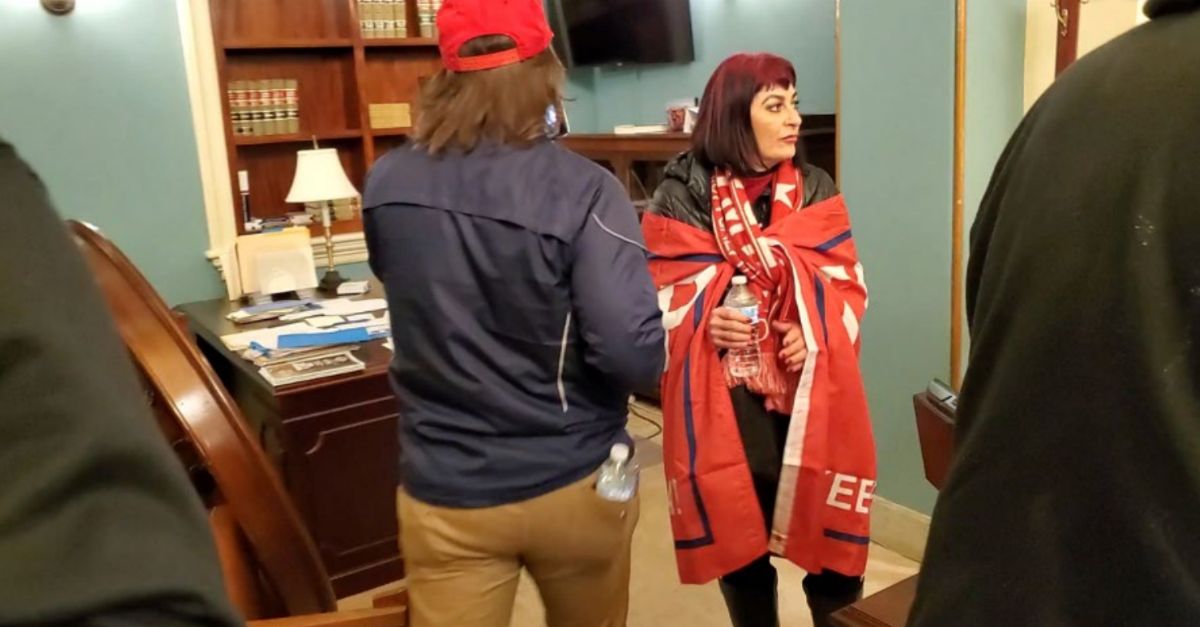
Tricia LaCount (U.S. Attorney’s Office).
An Oklahoma woman who cloaked herself in a Donald Trump flag and complained that Nancy Pelosi’s office was “so gaudy” after breaching the Capitol on Jan. 6 has received little more than a slap on the wrist for her role in the insurrection.
Tricia LaCount was sentenced on Tuesday to 36 months probation by U.S. District Court Judge Reggie B. Walton, a George W. Bush appointee. According to prosecutors, she attended Trump’s “Stop the Steal” rally and then marched to the Capitol, entering the building at 2:16 p.m., about 3 minutes after the initial breach of the Senate Wing Door. She left at 3:30 p.m.
LaCount was caught after a witness — a Facebook friend for 15 years — tipped off FBI agents. In a video the defendant shared on Facebook, LaCount is seen in the building that day.
“You got in the Capitol?!” a member of the Facebook conversation responded.
“Absolutely!” LaCount responded.
Then, referring to a second video showing her inside the office of the then-Speaker of the House, LaCount added, “Pelosi’s office is so gaudy … massive chandelier, beautiful fireplace … MSNBC live was on every laptop.”
LaCount was arrested on April 18, 2023, in Oklahoma. She pleaded guilty in July to trespassing.
In her sentencing memo seeking one month of home confinement, a period of supervised release or one year of probation, her defense attorney Stephen Brennwald admitted that LaCount went into the Capitol and was “awed by the building’s architecture” as she had never been inside the building before.
“Unfortunately, she did not know her way around the Capitol and consequently followed the crowd from hall to hall,” the document said. “At one point she briefly ended up in the office of former House Speaker Nancy Pelosi. Her presence there was completely by accident, as she did not know anything about the layout of the Capitol and was not searching for that particular location.”
Brennwald said she did not destroy anything and was not violent that day, saying she even gave a bottle of water to an officer to help him rinse his teargassed eyes.
“Video recordings of her path through the Capitol does not show a woman who looked angry, upset, or enraged, as many other individuals appeared to be,” the document said. “Rather, Ms. LaCount was simply ‘there,’ following the crowd wherever it went.”
“It is safe to say that of all the people who entered the Capitol building that day, Ms. LaCount’s actions were at the very bottom rung of criminality,” the lawyer added.
Prosecutors had sought a sentence of 60 days behind bars.
On Nov. 12 Brennwald filed a motion to postpone LaCount’s sentencing hearing in the wake of the Nov. 4 presidential win by Donald Trump, who promised massive pardons and signaled that he would order the dismissal of Jan. 6 cases — prompting multiple defendants to make similar legal maneuvers, with varying degrees of success.
“As this Court is aware, the recent election resulted in the return of the former president to the presidency,” Brennwald wrote. “The former president promised that he would dismiss cases involving the events that occurred on January 6, 2021, and/or pardon those involved. Proceeding with the hearing tomorrow would result in a waste of resources. It would needlessly take the time of the Court, government counsel, defense counsel, and court staff. Moreover, proceeding to sentencing rather than continuing the sentencing would result in a final conviction for Ms. LaCount. This would mean that rather than eventually having her case dismissed, she would now have to submit a pardon application — something that would be expensive and time-consuming.”
“There is no purpose defendant can discern in going forward tomorrow rather than pushing the hearing back several months, until the new administration can dispose of these cases as it has said it will,” he added.
The judge denied the motion.
“As the Court has noted in other cases, ‘the potential future exercise of the discretionary pardon power, an Executive Branch authority, is irrelevant to the Court’s obligation to carry out the legal responsibilities of the Judicial Branch,” the order said.








